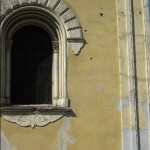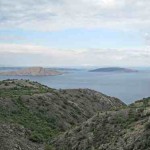
Zadar is the largest city on the north Dalmatian coast with a population of around 70,000. Its historic centre lies on a peninsular only 500m wide with a Roman street pattern containing marble paved traffic-free streets and a wealth of Roman remains and historic buildings. Chief amongst these is St. Donat’s Church, an amazing circular building which dates from the beginning of the ninth century.
Although located in Western (Roman Catholic) Europe, the Church is of early Byzantine (Eastern Orthodox) style. What makes it even more fascinating is that it was built over part of the Roman forum that dates from the 1st century BC to the 3rd century AD. Therefore, incorporated into the Church are two complete Roman pillars, together with other stonework containing Latin inscriptions. It is possible to climb a stone stairway to a first floor arcade and walk completely around in a circle looking down on the ground floor.
Outside of the Church, there are many more Roman remains including another pillar that was used as a ‘shame post’ during mediaeval times. It is ironic that some of these Roman remains were only discovered as a result of allied bombing during World War II which destroyed the more recent properties which had been built on top of them.
Walking around this fascinating city on a sunny Tuesday afternoon and Wednesday morning in July 2009, it was hard to believe that less than 18 years previously, it had once more been part of a war zone, under siege for three months from Serb gunners during the Croat – Serb war that resulted from the break-up of the former Yugoslavia. Now it is a bustling city, welcoming the visiting tourist and resident citizen alike and displaying a wealth of history stretching back more than 2000 years.


